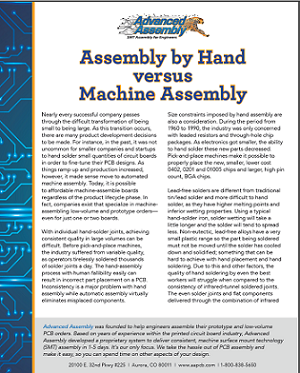
Nearly every successful company passes through the difficult transformation of being small to being large. As this transition occurs, there are many product development decisions to be made. For instance, in the past, it was not uncommon for smaller companies and startups to hand solder small quantities of circuit boards in order to fine-tune their PCB designs. As things ramp up and production increased, however, it made sense move to automated machine assembly. Today, it is possible to affordable machine-assemble boards regardless of the product lifecycle phase. In fact, companies exist that specialize in machine assembling low-volume and prototype orders—even for just one or two boards.
With individual hand-solder joints, achieving consistent quality in large volumes can be difficult. Before pick-and-place machines, the industry suffered from variable quality, as operators tirelessly soldered thousands of solder joints a day. The hand-assembly process with human fallibility easily can result in incorrect part placement on a PCB. Inconsistency is a major problem with hand assembly while automatic assembly virtually eliminates misplaced components. Size constraints imposed by hand assembly are also a consideration. During the period from 1960 to 1990, the industry was only concerned with leaded resistors and through-hole chip packages. As electronics got smaller, the ability to hand solder these new parts decreased. Pick-and-place machines make it possible to properly place the new, smaller, lower cost 0402, 0201 and 01005 chips and larger, high pin count, BGA chips.
Advertisement
Learn more about Advanced Assembly





